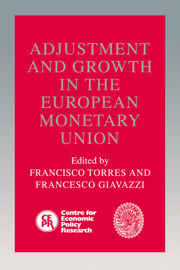Book contents
- Frontmatter
- Contents
- List of figures
- List of tables
- Preface
- List of contributors
- Foreword
- 1 Introduction
- 2 Economic and monetary union: critical notes on the Maastricht Treaty revisions
- Discussion
- 3 The design of optimal fiscal rules for Europe after 1992
- Discussion
- 4 Contracts, credibility and common knowledge: their influence on inflation convergence
- Discussion
- 5 Inflation in fixed exchange regimes: the recent Portuguese experience
- Discussion
- 6 Models of economic integration and localized growth
- Discussion
- 7 Shocking aspects of European monetary integration
- Discussion
- 8 Lessons of Massachusetts for EMU
- Discussion
- 9 Financial and currency integration in the European monetary system: the statistical record
- Discussion
- 10 Currency substitution: from the policy questions to the theory and back
- Discussion
- 11 Coordination of capital income taxes in the economic and monetary union: what needs to be done?
- Discussion
- Index
6 - Models of economic integration and localized growth
Published online by Cambridge University Press: 29 January 2010
- Frontmatter
- Contents
- List of figures
- List of tables
- Preface
- List of contributors
- Foreword
- 1 Introduction
- 2 Economic and monetary union: critical notes on the Maastricht Treaty revisions
- Discussion
- 3 The design of optimal fiscal rules for Europe after 1992
- Discussion
- 4 Contracts, credibility and common knowledge: their influence on inflation convergence
- Discussion
- 5 Inflation in fixed exchange regimes: the recent Portuguese experience
- Discussion
- 6 Models of economic integration and localized growth
- Discussion
- 7 Shocking aspects of European monetary integration
- Discussion
- 8 Lessons of Massachusetts for EMU
- Discussion
- 9 Financial and currency integration in the European monetary system: the statistical record
- Discussion
- 10 Currency substitution: from the policy questions to the theory and back
- Discussion
- 11 Coordination of capital income taxes in the economic and monetary union: what needs to be done?
- Discussion
- Index
Summary
Introduction and overview
European economies are fast approaching complete integration, with elimination of legal restrictions to trade and factor mobility, increasing credibility of fixed exchange rates, and better coordination of economic policies. The legal and institutional process of economic integration among the ‘core’ countries of the European Community (EC) will be essentially complete by the end of 1992. As linguistic and cultural barriers to economic interaction weaken as well, Europe should soon become as much of a single economic entity as the United States of America. The question naturally arises of what difference this will make to overall economic performance on the one hand, and to regional developments on the other.
If economic borders represented artificial restrictions in an otherwise undistorted economic system, their elimination would necessarily yield welfare improvements at the aggregate level. An integrated Europe should then enjoy increased production efficiency and faster capital accumulation. Baldwin (1989) and Rivera-Batiz and Romer (1991) studied the effects of economic integration in models of investment-driven economic growth. Increasing returns to scale are crucial to the mechanics of growth in models which account for use in production of non-accumulated factors (such as land and labour). Since constant returns to accumulation of knowledge and/or physical capital are necessary for investment to sustain steady growth, aggregate production must have increasing returns to scale as a function of accumulated and non-accumulated factors together.
- Type
- Chapter
- Information
- Adjustment and Growth in the European Monetary Union , pp. 159 - 189Publisher: Cambridge University PressPrint publication year: 1993
- 10
- Cited by



